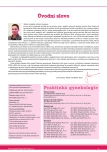Pregnancy and delivery by a patient with tension-free vaginal tape – case report and literature review
Authors:
K. Sedláková; Martin Huser; I. A. Belkov; Petr Janků
Authors‘ workplace:
Gynekologicko-porodnická klinika, LF MU a FN Brno
Published in:
Prakt Gyn 2011; 15(1): 42-46
Category:
Case Report
Overview
Objective:
We present a case report and available medical data and standards for the management of pregnant women with a history of stress urinary incontinence (SUI) treated by tension-free vaginal tape (TVT) insertion. If SUI is treated surgically by TVT and the patient becomes pregnant, it is necessary to individually consider possible ways of delivery. During pregnancy and vaginal delivery in particular, a change in the position of the tape could theoretically occur, causing deterioration of continence; the options for the management of such incontinence are then very limited. Therefore, selection of the appropriate mode of delivery way is important. Literature on the risk of SUI recurrence during pregnancy and delivery after TVT insertion is very scarce. This paper presents a case of 29-year-old woman with TVT, who delivered vaginally without SUI recurrence. This paper further presents available data on this issue and suggestions on how to manage these cases.
Case report:
We describe a case of a young woman with a history of SUI and after the TVT procedure. The patient was monitored in our clinic from her 37th week of pregnancy. She wanted to deliver vaginally. In the 38th week of her pregnancy urological and gynaecological examination was performed and there was no evidence of SUI. Subsequently, considering her wish and after she was informed on the possibility of SUI recurrence, vaginal delivery was agreed upon. The patient later delivered spontaneously without complications. No perineal or vaginal injury was found during delivery and the patient was discharged on day 3 postpartum without any symptoms of SUI. Follow up urological and gynaecological examination 6 weeks after delivery confirmed full urinary continence.
Conclusion:
There is no clear consensus on the mode of delivery after TVT insertion. Elective caesarean section in not absolutely indicated, but it is preferred in the majority of these cases. There is no evidence of protective effects of elective caesarean section on the SUI recurrence risk reduction. Pregnancy is considered a risk factor for SUI recurrence. According to the available literature, vaginal delivery compared to elective caesarean section probably does not increase the risk of SUI recurrence. If there are no symptoms of SUI during pregnancy, vaginal delivery is possible, although most gynaecologists are more likely to prefer caesarean section.
Key words:
stress urinary incontinence – tension-free vaginal tape – caesarean section – pregnancy – delivery
Sources
1. Belkov I, Huser M. Inkontinence moči u žen – možnosti její korekce. Interní Med 2009; 11(8): 351–354.
2. DeLancey JO. Structural support of the urethra as it relates to stress urinary incontinence: the hammock hypothesis. Am J Obstet Gynecol 1994; 170(6): 1713–1723.
3. Belkov I, Huser M, Pasorčáková M. Miniinvazivní techniky v léčbě stresové inkontinence moči. Prakt Gyn 2009; 13 (Suppl 1): 194–195.
4. Nilsson CG, Falconer C, Rezapour M. Seven-year follow-up of the tension-free vaginal tape procedure for treatment of urinary incontinence. Obstet Gynecol 2004; 104(6): 1259–1262.
5. Peyrat L, Haillot O, Bruyere F et al. Prevalence and risk factors of urinary incontinence in young and middle-aged women. BJU Int 2003; 89(1): 61–66.
6. Thom DH, Rortveit G. Prevalence of postpartum urinary incontinence: a systematic review. Acta Obstet Gynecol Scand 2010; 89(12): 1511–1522.
7. Press JZ, Klein MC, Kaczorowski J et al. Does cesarean section reduce postpartum urinary incontinence? A systematic review. Birth 2007; 34(3): 228–237.
8. Groutz A, Rimon E, Peled S et al. Cesarean section: does it really prevent the development of postpartum stress urinary incontinence? A prospective study of 363 women one year after their first delivery. Neurourol Urodyn 2004; 23(1): 2–6.
9. Iskander MN, Kapoor D. Pregnancy following tension-free vaginal taping. Int Urogynecol J Pelvic Floor Dysfunct 2000; 11(3): 199–200.
10. Gauruder-Burmester A, Tunn R. Pregnancy and labor after TVT-plasty. Acta Obstet Gynecol Scand 2001; 80(3): 283–284.
11. Seeger D, Truong ST, Kimmig R. Spontaneous delivery following tension-tree vaginal tape procedure. Int Urogynecol J Pelvic Floor Dysfunct 2005; 28: 1–3.
12. Le Roc’h A, Debondinance P. Pregnancy after sub-urethral tape by the trans-obturator route. J Gynecol Obstet Biol Reprod 2006; 35: 191–193.
13. Demaria F, Chanelles O, Boquet B et al. Vaginal delivery after tension-free vaginal tape procedure. Int Urogynecol J Pelvic Floor Dysfunct 2007; 18(11): 1363–1365.
14. Vella M, Robinson D, Brown R et al. Pregnancy and delivery following tension-free vaginal tape. Int Urogynecol J Pelvic Floor Dysfunct 2007; 18(3): 347–348.
15. Panel L, Triopon G, Courtieu C et al. How to advise a woman who wants to get pregnant after a sub-urethral tape placement? Int Urogynecol J Pelvic Floor Dysfunct 2008; 19(3): 347–350.
16. Arunkalaivanan AS, Barrington JW. Questionnaire-based survey on obstetricians and gynaecologists’ attitudes towards the surgical management of urinary incontinence in women during their childbearing years. Eur J Obstet Gynecol Reprod Biol 2003; 108(1): 85–93.
Labels
Paediatric gynaecology Gynaecology and obstetrics Reproduction medicineArticle was published in
Practical Gynecology

2011 Issue 1
Most read in this issue
- Necrotic myoma in pregnancy
- The methods of skeletal age assessment
- Cryopreservation of cells and tissues in assisted reproduction
- Correlation between ultrasound, hysteroscopy and histological picture of endometrial polyps
